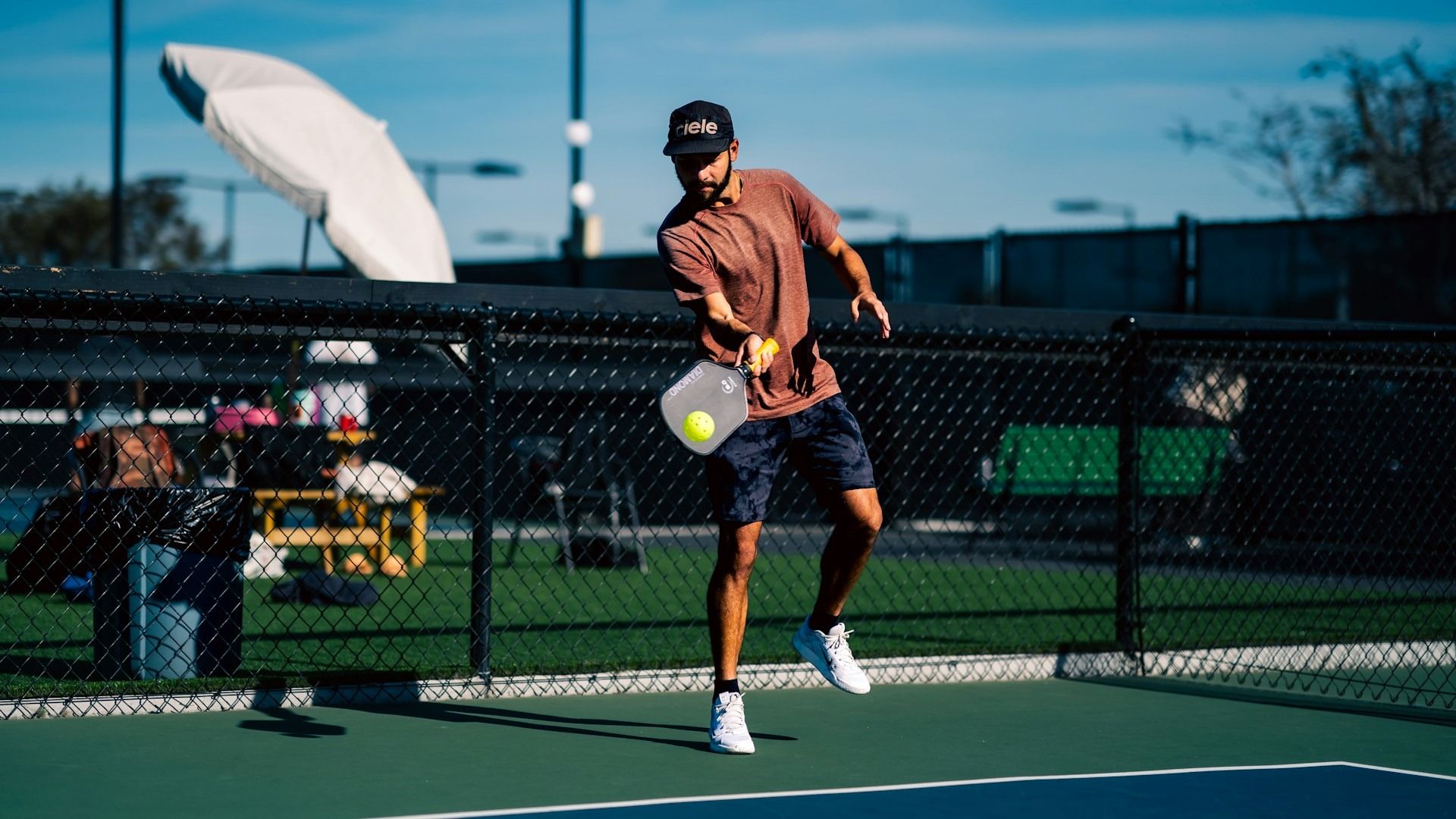Essential Pickleball equipment guide for beginners
Discover must-have pickleball gear, from paddles to balls and shoes, plus expert buying tips and how Rezerv studios can support equipment-based classes.
.jpg)
Source: Hong Son on Pexels
Pickleball might just be the fastest-growing sport you’ve been hearing about, and for good reason. It’s fun, social, and surprisingly easy to pick up, even if you’ve never swung a racket before. Imagine tennis, ping pong, and badminton had a baby, that’s pickleball. The court is smaller than tennis, the ball is lighter, and the paddle is bigger than a ping pong paddle but less intimidating than a racket. The best part? Anyone can play, no matter your age or fitness level.
But here’s the thing: just like any sport, having the right equipment can make all the difference. You don’t need to buy every fancy gadget out there, but a good paddle, the right shoes, and a few basics will help you feel more confident and enjoy the game a whole lot more. Think of it as setting yourself up for success, because nothing kills the fun faster than sore feet, a slippery grip, or a paddle that feels like a brick in your hands.
This article is here to break it all down for you. From the essential gear every beginner should start with, to the best paddles at different skill levels, plus tips on how to choose the right equipment for you, we’ll cover it all. By the end, you’ll know exactly what you need to step onto the court ready to play.
The Basics: Paddle, Ball, Court Shoes, and Net
Before you start thinking about advanced paddles or tournament gear, let’s nail down the essentials every beginner needs. Pickleball doesn’t require a long shopping list—you just need a few key items to get started.
1. Paddle
The paddle is the star of the game. Unlike a tennis racket, there are no strings. Instead, pickleball paddles are solid, lightweight, and come in different materials like fiberglass, graphite, or carbon fiber. Beginners usually do best with a paddle that’s lightweight and has a larger sweet spot (the hitting zone). This makes it easier to connect with the ball and control your shots without feeling like you’re swinging a heavy bat.
2. Ball
Pickleball uses a plastic ball with holes, similar to a Wiffle ball. There are two main types: indoor and outdoor. Indoor balls are softer and have larger holes, while outdoor balls are slightly harder and made to handle wind and rougher surfaces. If you’re just getting started, make sure you’re using the right ball for your playing environment, it can really change how the game feels.
3. Court shoes
This one’s often overlooked, but wearing the right shoes is just as important as having the right paddle. Running shoes might seem fine at first, but they’re designed for forward motion, not side-to-side movement. On the pickleball court, you’ll be doing a lot of quick lateral steps, so look for court shoes (often labeled for tennis or volleyball). These give you better grip, ankle support, and stability so you don’t end up slipping or straining something.
4. Net
If you’re playing at a community center or club, the net is already there. But if you’re setting up your own game in a driveway, park, or gym, you’ll need a portable pickleball net. They’re easy to assemble, meet official height standards (36 inches at the sidelines, 34 inches in the middle), and can be packed away when you’re done.
Think of these four pieces of equipment as your starter kit. With just a paddle, a few balls, the right shoes, and access to a net, you’ll have everything you need to jump into the game and actually enjoy it from day one.
Best paddles by skill level
When it comes to pickleball paddles, not all are created equal. The right paddle can make a huge difference in how you play, helping you feel more in control, boosting your confidence, and even preventing fatigue. Here’s a quick breakdown of paddle recommendations depending on where you are in your pickleball journey.
For Beginners
.jpg)
Source: www.joola.com
If you’re brand new, you don’t need to splurge on the most expensive paddle out there. Look for something lightweight, forgiving, and budget-friendly. A great example is the Joola Essentials Performance Pickleball Paddle, which is designed with a larger hitting zone and a comfortable grip, making it easy to control and perfect for learning the game. Another beginner-friendly option is the Niupipo Pickleball Paddles Set of 2, affordable, durable, and ideal if you’re testing the waters without a big investment.
For Intermediate Players
.jpg)
Source: www.head.com
Once you’ve been playing for a while and want to level up, it’s worth upgrading to a paddle that offers a balance of power and control. The Head Radical Elite Pickleball Paddle is a strong mid-range choice. It’s lightweight, designed with a larger sweet spot, and helps you refine your shots without sacrificing comfort. At this stage, you’ll start noticing how paddle weight and surface material affect your play style, so experimenting with different models can be helpful.
For Advanced Players
.jpg)
Source: www.joola.com
Experienced players often want more precision, spin, and power. The Joola Ben Johns Hyperion CFS 16 is a pro-level paddle designed in collaboration with the world’s top player. It combines power with control, has an elongated handle for grip versatility, and a carbon fiber surface that gives you excellent responsiveness. If you’re looking for even more edge, the Selkirk Vanguard Power Air Invikta is another standout, built for aggressive, high-speed play with a massive sweet spot.
For All-Around Players
.jpg)
Source: www.selkirk.com
If you’re the type who wants a paddle that works across all situations, whether you’re playing casually or pushing toward advanced games, the Selkirk Amped Control or Friday Pickleball Paddle are excellent versatile picks. They’re designed for a wide range of players and strike that balance between power and control, making them long-term investments you won’t outgrow quickly.
The takeaway? Start simple and forgiving when you’re new, then move toward paddles that give you more control and spin as your game improves. Choosing a paddle isn’t just about price, it’s about finding the right fit for your current skill level and style of play.
How to choose the right gear
Walking into a store (or scrolling online) and seeing dozens of paddles and accessories can feel overwhelming. The truth is, you don’t need to know every tiny technical detail, but understanding a few key factors will help you choose gear that feels comfortable and supports your style of play.
1. Grip comfort
The grip is where your hand meets the paddle, so it needs to feel natural. Too small, and you’ll lose stability. Too big, and your hand will tire quickly. A general rule: smaller grips give you more wrist action and spin, while larger grips offer more stability and control. If you’re unsure, test a couple of sizes or go slightly smaller, you can always build up the grip with overgrip tape.
2. Paddle weight
Weight is one of the biggest factors in how your paddle performs. Lightweight paddles (around 7–7.5 ounces) are easier to swing and put less strain on your arm, making them great for beginners or players who rely on quick reactions at the net. Mid-weight paddles (7.6–8.2 ounces) strike a balance between power and control. Heavy paddles (8.3 ounces and above) pack more punch but can be tiring if you’re not used to them. The best choice depends on your playing style, do you value speed and finesse, or power and drive?
3. Surface Material
Most paddles are made with either fiberglass, graphite, or carbon fiber. Fiberglass paddles offer great power and are often beginner-friendly. Graphite paddles are lightweight and responsive, perfect for players who want control and precision. Carbon fiber paddles are typically the most durable and deliver excellent spin and feel, making them a favorite for advanced players. While materials do influence performance, don’t get too caught up in the technicalities, focus on how the paddle feels in your hand and during play.
4. Shoes and Comfort Gear
Beyond the paddle, don’t underestimate footwear and accessories. Court shoes with proper grip and lateral support will prevent slips and injuries, while cushioned insoles or wristbands can reduce strain during longer games. Comfort is key, you’ll enjoy the game more if your body isn’t fighting against your equipment.
Using Rezerv to organize equipment for classes or workshops
If you’re just playing for fun, having your own paddle and a few balls is usually enough. But if you’re running classes, clinics, or workshops, the list of equipment can grow quickly. Between making sure everyone has the right paddles, enough balls to go around, and even extras like portable nets or court markers, it can get overwhelming to manage. That’s where Rezerv comes in handy.
Rezerv isn’t just about scheduling courts or managing bookings, it can also be a simple way to organize your equipment needs. For example, when you’re setting up a pickleball class in the system, you can list the gear participants should bring (like indoor shoes or their own paddle). If you’re providing equipment, you can add it to your class details so players know what’s available on-site. This helps avoid the classic “I didn’t know I needed that” moment for beginners who are showing up for the first time.
For larger workshops or community events, Rezerv makes it easy to create an equipment checklist alongside your schedule. You can track how many paddles, nets, and balls you’ll need for the session, and even assign staff to bring or set them up. It keeps everything streamlined so you spend less time on logistics and more time focusing on coaching or playing.
Conclusion
Pickleball is one of those rare sports that’s both beginner-friendly and endlessly engaging as you get better. With just a few essentials, a solid paddle, the right ball, supportive court shoes, and access to a net, you can start playing and having fun right away. From there, upgrading your gear as your skills grow will only make the game more enjoyable.
The key is choosing equipment that feels right for you. A comfortable grip, the right paddle weight, and quality materials all play a big role in how you perform on the court. And if you’re running classes or workshops, tools like Rezerv make it simple to keep track of what’s needed so players are never left unprepared.
At the end of the day, pickleball isn’t about having the most expensive paddle or the flashiest gear, it’s about enjoying the game, connecting with others, and improving one rally at a time. Get your basics covered, find gear that fits your style, and you’ll be ready to step onto the court with confidence.
Friska 🐨
Read next: Best Pickleball courts in Singapore

